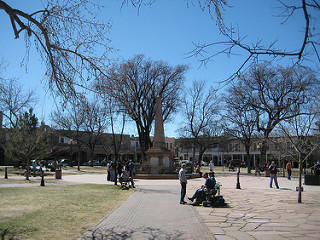 In June I was asked to speak to representatives of New Mexico’s Arts and Cultural Districts. The occasion provided me the opportunity to reflect on the intersection of creative placemaking and community engagement. Creative placemaking is designed, among other things, to bring “diverse people together to celebrate, inspire, and be inspired.” [Ann Markusen and Anne Gadwa, Creative Placemaking: http://arts.gov/sites/default/files/CreativePlacemaking-Paper.pdf] If arts organizations are participating in CP work, this is a description of community engagement.
In June I was asked to speak to representatives of New Mexico’s Arts and Cultural Districts. The occasion provided me the opportunity to reflect on the intersection of creative placemaking and community engagement. Creative placemaking is designed, among other things, to bring “diverse people together to celebrate, inspire, and be inspired.” [Ann Markusen and Anne Gadwa, Creative Placemaking: http://arts.gov/sites/default/files/CreativePlacemaking-Paper.pdf] If arts organizations are participating in CP work, this is a description of community engagement.
The presentation I gave in New Mexico reflected a revelation on my part about creative placemaking. These projects, that are becoming such an important part of the cultural landscape, have the capacity to create 21st-Century versions of the town square or plaza, the commons from earlier eras–places where people gathered to celebrate and be in community.
The full text of those remarks was very specific to New Mexico. I have created a condensed and generalized version that is available on the ArtsEngaged website: Creating the 21st-Century Commons. Even it, however, is too verbose for the purposes of a blog post. I am providing below a “Cliff’s Notes” outline of the main points.
What Is A Commons for the 21st Century?
A Place–a physical location where people can come together,
- Attractive/Inviting
- Appropriate (Scale, appearance, environmental fit)
- Memorable
An Idea–a concept or set of concepts that makes the community assume–even demand–ownership of that place,
- Barrier Free (No–or minimized–physical, economic, historic, or social impediments)
- Welcoming
- Community Defining (Including opportunities to create and build the community’s identity)
A Container of Events
- Vibrant center where attractive things always (or with great regularity) happen
- Crucible for Relationship Building within and between all local communities
And, from the perspective of the presenters of arts and culture,
A Cultural Commons that
- Reflects the local community
- Is welcoming to all.
There is a need for places for community members to come together, to interact, to learn from each other, to form social bonds. Arts organizations, partnering with community members on creative placemaking projects can have an active hand in making more livable communities. And, it’s no coincidence that doing so will also greatly enhance the visibility, stature, and, ultimately, viability of those organizations.
Engage!
Doug
Photo:![]() Some rights reserved by puroticorico
Some rights reserved by puroticorico
